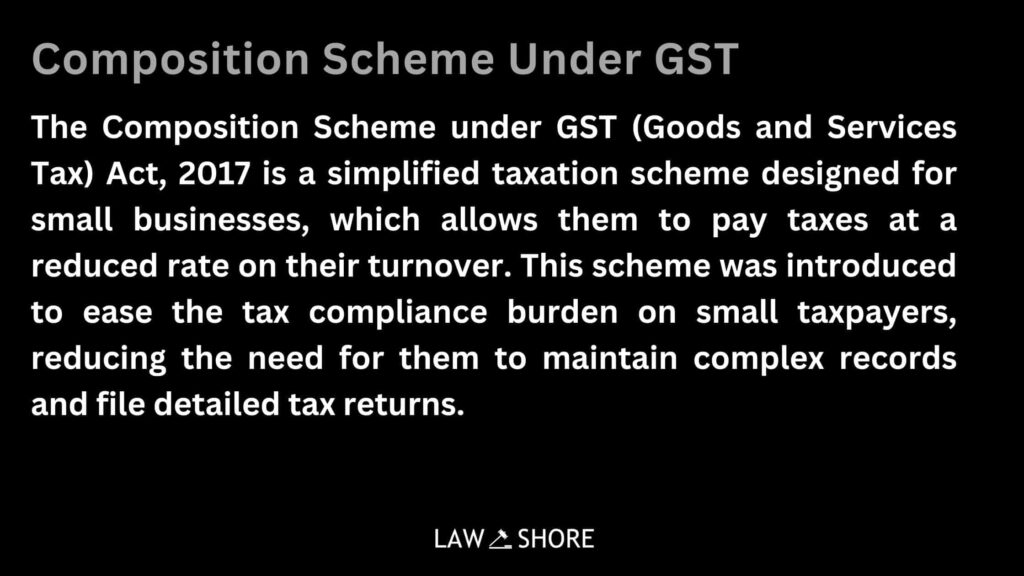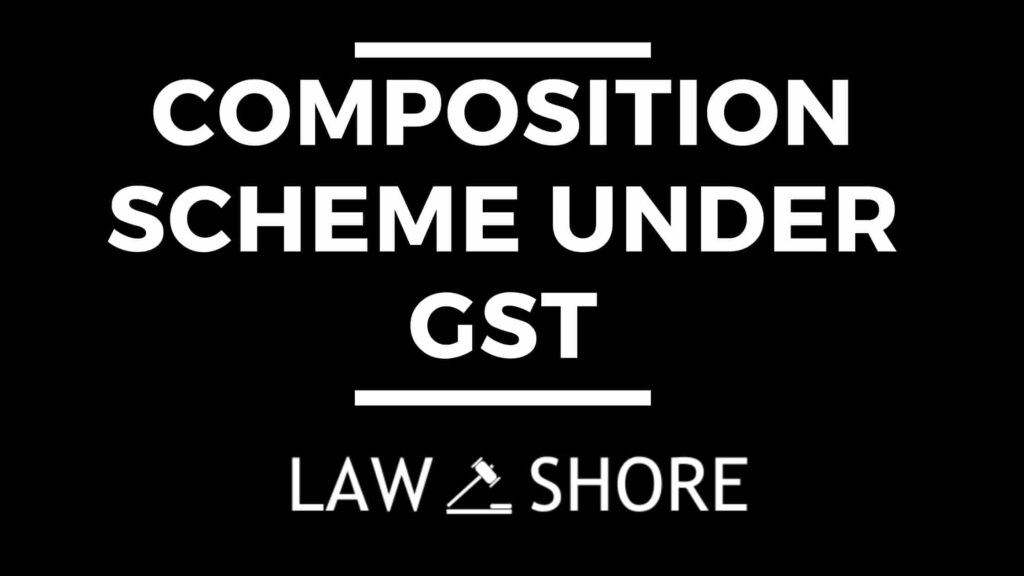Composition Scheme Under GST Act, 2017
Table of Contents
ToggleWhat is the Composition Scheme under GST?
The Composition Scheme under GST (Goods and Services Tax) Act, 2017 is a simplified taxation scheme designed for small businesses, which allows them to pay taxes at a reduced rate on their turnover. This scheme was introduced to ease the tax compliance burden on small taxpayers, reducing the need for them to maintain complex records and file detailed tax returns.
The Composition Scheme is available under Section 10 of the GST Act and is intended to help small businesses, including manufacturers, traders, and certain service providers, by providing a simpler way to comply with the GST system.

Explanation of Section 10:
Section 10 allows small businesses to opt for the Composition Scheme, which simplifies their tax compliance. Instead of paying GST at regular rates, these businesses pay a lower rate (1%, 5%, or 6%) on their turnover.
However, businesses under the scheme cannot claim Input Tax Credit (ITC) and are restricted to making only intra-state supplies. Additionally, the scheme is meant for businesses with a turnover limit (usually ₹1.5 crore) and does not cover e-commerce operators or inter-state suppliers. If the business exceeds the turnover limit or wishes to leave the scheme, it must switch to the regular GST regime and comply with the standard GST filing rules.
Who is eligible to opt for the Composition Scheme under GST?
Eligibility Criteria for the Composition Scheme under GST Act, 2017 –
Turnover Limit –
The aggregate turnover of the business is one of the main eligibility criteria for the Composition Scheme. The limits vary based on the type of business and the region. These limits are as follows:
- For most states (general category states): The aggregate turnover must not exceed ₹1.5 crore in the preceding financial year.
- For special category states (e.g., Assam, Jammu & Kashmir, Himachal Pradesh, etc.) The turnover limit is ₹75 lakh in the preceding financial year.
Important Notes:
- Aggregate turnover refers to the sum of the turnover of all business verticals of the taxpayer, but excluding the value of exports, inward supplies of goods and services on which the tax is paid under reverse charge mechanism (RCM), and exempted supplies.
- Businesses exceeding the turnover limit in any financial year are required to leave the Composition Scheme and shift to the regular GST tax regime.
Type of Business Activity-
To be eligible for the Composition Scheme, the business must fall into one of the following categories:
- Manufacturers: A taxpayer engaged in the manufacturing of goods can opt for the Composition Scheme, as long as they meet the turnover criteria.
- Traders/Dealers: A person engaged in the supply of goods, i.e., a retailer or wholesaler, can also avail the Composition Scheme, provided the turnover does not exceed the prescribed limit.
- Service Providers (Limited Scope): Service providers can opt for the Composition Scheme only if their turnover does not exceed ₹50 lakh in the preceding financial year. However, this benefit is available only for those providing services other than restaurant services. For restaurant services, the scheme is available without any turnover restriction.
Ineligible Businesses
Certain businesses and sectors are not eligible to opt for the Composition Scheme. These include:
- Businesses with inter-state supply: Any business that makes inter-state supply of goods or services is not eligible. The Composition Scheme is strictly limited to intra-state sales.
- E-commerce operators: Businesses engaged in the supply of goods or services through an e-commerce platform (e.g., Amazon, Flipkart, etc.) cannot opt for the Composition Scheme. This is because such businesses must collect and remit taxes on behalf of their suppliers.
- Manufacturers of certain goods: Certain goods, such as tobacco products, pan masala, and ice cream, are excluded from the Composition Scheme.
Service providers (except for small restaurants): Service providers, in general, are not eligible, except for small restaurant service providers (with turnover less than ₹50 lakh).
No Input Tax Credit (ITC)
- A business opting for the Composition Scheme cannot claim Input Tax Credit (ITC) on the tax paid on its purchases. This means that the tax paid on raw materials, goods, or services purchased cannot be used to offset the GST liability on its sales.
- This is a significant limitation for businesses that wish to reduce their tax burden by claiming ITC.
No Supply of Exempt Goods or Services
A taxpayer under the Composition Scheme is not allowed to supply exempted goods or services. If a business supplies exempted goods, it will no longer be eligible for the scheme.
Other Conditions
- No Collection of Tax: A taxpayer under the Composition Scheme cannot collect GST from their customers. The tax is payable on the turnover, but it is the responsibility of the business to pay the tax out of pocket rather than passing it on to customers.
- Business Cannot Use the Scheme for Mixed Supplies: If the business deals with a combination of taxable and exempt supplies, it must ensure that it does not exceed the limits or violate any conditions that would make it ineligible for the Composition Scheme.
How does a business opt for the Composition Scheme under GST?
A business can opt for the Composition Scheme at the time of its GST registration or at the beginning of a new financial year. The steps are as follows:
- During GST Registration:
When applying for GST registration, the business can indicate its intention to opt for the Composition Scheme in Form GST REG-01. - Existing GST-Registered Businesses:
An existing taxpayer can opt for the Composition Scheme by filing Form GST CMP-02 (Intimation of Option to Pay Tax under Composition Scheme). - Annual Intimation:
The business must also file Form GSTR-4 for the quarterly returns and Form GSTR-9A for the annual return.
A business must ensure that it meets all eligibility criteria before opting for the scheme.
What is the tax rate under the Composition Scheme under GST?
The tax rate under the Composition Scheme is significantly lower compared to regular GST rates. The rates are as follows:
- 1% of the turnover for manufacturers and traders (retailers and wholesalers).
- 5% of the turnover for businesses providing restaurant services.
- 6% of the turnover for businesses dealing with both goods and services (mixed supplies).
These rates are applicable to the aggregate turnover, not on the value of individual supplies.
Can a business registered under the Composition Scheme claim Input Tax Credit (ITC)?
No, businesses under the Composition Scheme cannot claim Input Tax Credit (ITC) on the tax paid on their purchases. This means that they cannot offset the tax they pay on purchases of raw materials, goods, or services against the tax collected on their sales.
This is one of the key limitations of the Composition Scheme. However, businesses can benefit from the simplified compliance process and lower tax rates.
Can a business under the Composition Scheme make inter-state sales?
No, businesses registered under the Composition Scheme cannot make inter-state sales. They are restricted to selling goods or services only within the same state. This is a significant limitation of the scheme for businesses that want to expand their market to other states.
If a business registered under the Composition Scheme engages in inter-state sales, it will no longer be eligible for the scheme and will have to switch to the regular GST regime.
How is the tax calculated under the Composition Scheme?
The tax under the Composition Scheme is calculated based on the turnover of the business rather than the value of individual supplies. This simplifies the process for small businesses as they do not need to calculate tax on each supply. Instead, they pay tax on their total turnover for the period.
How often do businesses under the Composition Scheme need to file returns and pay taxes?
Businesses under the Composition Scheme are required to pay tax quarterly. However, they must file an annual return using Form GSTR-4 to report their total turnover for the financial year. The quarterly returns simplify tax compliance for smaller businesses by reducing the frequency of reporting.
Can a Composition Scheme taxpayer collect GST from their customers?
No, businesses under the Composition Scheme cannot collect GST from their customers. Instead, they must absorb the tax burden themselves and pay it to the government. This is one of the main differences between the regular GST system and the Composition Scheme, where regular taxpayers collect tax from their customers and remit it to the government.
Can a business under the Composition Scheme supply exempted goods or services?
No, a business registered under the Composition Scheme cannot supply exempted goods or exempted services under the GST Act. If a business wishes to supply goods or services that are exempt from GST, it will not be eligible for the Composition Scheme and must follow the regular GST rules.
Can a taxpayer opt out of the Composition Scheme during the year?
Yes, a taxpayer can opt out of the Composition Scheme at any time during the financial year. However, if the business exceeds the turnover limit or if the business decides to leave the scheme for any other reason, they must notify the tax authorities. The business will then need to follow the regular GST procedures.
What happens if the turnover exceeds the prescribed limit under the Composition Scheme?
If a business’s turnover exceeds the prescribed limit (₹1.5 crore for most states, ₹75 lakh for special category states) during the financial year, it must exit the Composition Scheme. The taxpayer will then need to switch to the regular GST system, file monthly returns, and comply with the standard GST tax rates and procedures.
Forms Relevant for the Composition Scheme under GST Act, 2017
The Composition Scheme under Goods and Services Tax (GST) Act, 2017 simplifies compliance for small businesses by reducing the number of returns and records required to be maintained. There are specific forms related to the Composition Scheme that taxpayers need to be familiar with. These forms are primarily related to registration, returns, and payment of tax.
Form GST CMP-02
Intimation of Option to Pay Tax under Composition Scheme
- Purpose: This form is used by a taxpayer to opt for the Composition Scheme at the time of GST registration or when the taxpayer decides to switch to the Composition Scheme from the regular scheme.
- When to file: It must be filed when the taxpayer is applying for GST registration or wants to choose the Composition Scheme for the current financial year.
- Content: The form contains details of the business, turnover, and the intention to opt for the Composition Scheme.
Form GST CMP-03
Intimation of Withdrawal from the Composition Scheme
- Purpose: If a business exceeds the eligibility limits or wishes to voluntarily withdraw from the Composition Scheme, they must use this form to intimate the authorities about their decision to opt out.
- When to file: This form is filed when a taxpayer becomes ineligible for the Composition Scheme (e.g., turnover exceeds the threshold limit) or wishes to discontinue the scheme during the financial year.
- Content: The form asks for details of the reasons for withdrawal and other necessary details related to the business.
Form GSTR-4:
Quarterly Return for Composition Scheme
- Purpose: This form is used to file quarterly returns by businesses registered under the Composition Scheme. It contains details about the outward supplies made during the quarter and the tax paid.
- When to file: It is required to be filed quarterly, even if there are no transactions in the quarter.
- Content: The form includes details of:
– Outward supply details: Taxable turnover of the business, including inter-state supplies (if any).
– Tax liability: Calculation of tax payable under the Composition Scheme.
– Tax paid: Details of the tax payment made.
Form GSTR-9A:
Annual Return for Composition Scheme
- Purpose: This form is used to file the annual return by taxpayers under the Composition Scheme. It consolidates all the quarterly returns filed during the year.
- When to file: It must be filed once every financial year, and the due date for filing is generally 31st December of the following year (though this may vary as per the government’s notification).
- Content: The form includes:
– Summary of taxable turnover for the entire year.
– Details of the quarterly returns filed.
– Reconciliation of tax paid and any discrepancies or adjustments in the tax liability.
Form GST REG-01:
Application for GST Registration (Opting for Composition Scheme)
- Purpose: This is the application form used to register for GST, where a taxpayer can choose to opt for the Composition Scheme at the time of their registration.
- When to file: This form is required to be filed when a new business is being registered under GST, and the business wants to opt for the Composition Scheme.
- Content: This form collects basic details of the business and allows the taxpayer to indicate their preference for the Composition Scheme under Section 10 of the GST Act.
Form GST REG-16:
Confirmation of Composition Scheme Registration
- Purpose: This form is issued by the GST department as a confirmation of registration under the Composition Scheme once the application in Form GST REG-01 is approved.
- When to file: This form is issued after the successful registration of the taxpayer under the Composition Scheme.
- Content: The form confirms that the taxpayer has been enrolled under the Composition Scheme and will follow the reduced tax rates and simplified return filing process.
Form GST PMT-06
Payment of Tax under the Composition Scheme
- Purpose: This form is used to make payment of tax for taxpayers who have opted for the Composition Scheme. It is used for making quarterly tax payments.
- When to file: It must be filed when making payments for the tax due under the Composition Scheme for each quarter.
- Content: The form contains: Details of tax payment: Amount payable for the relevant quarter under the Composition Scheme.
- Challan number: A unique number generated for the payment made.
Can a business under the Composition Scheme switch to the regular GST scheme during the year?
Yes, a business under the Composition Scheme can switch to the regular GST scheme at any point during the year if it exceeds the turnover limit or for any other reason. The following steps must be taken:
- File Form GST CMP-03: This form must be filed to intimate the authorities about the withdrawal from the scheme.
- Once the business withdraws from the Composition Scheme, it will need to follow the regular GST filing procedure (monthly returns, regular ITC, etc.).
It is important for businesses to ensure that they exit the scheme promptly if they exceed the turnover limit or if they are no longer eligible.
What happens if a business exceeds the turnover limit under the Composition Scheme under GST?
If a business exceeds the turnover limit specified for the Composition Scheme, it is no longer eligible to continue under the scheme. In such cases:
- The business must withdraw from the scheme by filing Form GST CMP-03.
- It will have to start paying GST under the regular GST scheme.
- The business will need to file monthly returns (GSTR-1, GSTR-3B, etc.) and claim Input Tax Credit (ITC) on purchases.
If the turnover limit is exceeded during a financial year, the business must switch to the regular GST system and comply with the regular tax rates and filing procedures.
Benefits of the Composition Scheme Under GST
- Simplicity: The scheme simplifies tax compliance by reducing the number of returns and paperwork required, making it easier for small businesses to comply with tax regulations.
- Lower Tax Burden: Small businesses are able to pay tax at a lower rate compared to the regular GST rate, which can significantly reduce their tax liability.
- Cash Flow Relief: Since no Input Tax Credit is available, businesses under this scheme generally face lower administrative and compliance costs, making their overall operations more efficient.
Limitations of the Composition Scheme Under GST
- No Input Tax Credit (ITC): As mentioned earlier, one of the key drawbacks of the Composition Scheme is that businesses cannot avail ITC, which could have helped reduce their overall tax liability.
- Restricted to Small Businesses: The scheme is available only to businesses with a limited turnover, so it is not an option for larger businesses.
Limited Scope for Inter-State Sales: The scheme prohibits inter-state sales, limiting the business’s ability to expand its market geographically. - No Supply of Certain Goods or Services: Certain goods (such as tobacco and liquor) and certain services are not eligible for the scheme, limiting the range of business activities that can benefit from it.
Conclusion
The Composition Scheme under GST Act, 2017 is a beneficial scheme aimed at easing the tax burden for small businesses by offering a simplified and lower tax regime. While the scheme offers several advantages such as lower tax rates and simplified compliance, it also comes with limitations such as the inability to claim Input Tax Credit and restrictions on inter-state sales. Therefore, businesses should carefully assess their eligibility and weigh the advantages and disadvantages before opting for the Composition Scheme.
Explore Law Shore: law notes today and take the first step toward mastering the fundamentals of law with ease.

After Completing my LLB hons, I started writing content about legal concepts and case laws while practicing. I finally started Law Shore in 2024 with an aim to help other students and lawyers.

